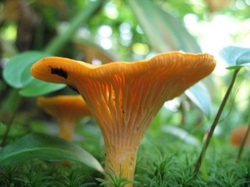"Do you want to go mushroom hunting today?" Kmart asks. Of course I do. I've already scheduled my day: writing, editing, and cleaning the house. But mushroom hunting it is. I'm not passing up this golden opportunity. And hey, I may not be working, but at least, with Kmart's help, I'll be putting food on the table. Si Dios quiere, as the Mexicans say.
Kmart's favorite pastimes are drinking beer (Ninkasi IPA, to which she is rabidly devoted) and gardening. She is notable for her mulish disposition and sloth-like tendencies. We grew up together, a few miles apart on a one-lane gravel road, and we were always biking back and forth between each other's houses. The early years of our friendship are notable for a number of failed business ventures (moldering rose petal sachets, anyone?) and a deep respect for Jon Bon Jovi.
I left home in 1994. And for many years now, hanging out with Kmart has required elaborate machinations, such as driving 6 hours on the freeway and, you know, planning.
Now, for the first time in 17 years, I'm living in the sticks again, in Deadwood, Oregon, on the same gravel road, just miles from my old friend. A few minutes after receiving the coveted invitation, I'm ready to go.
Awkward in rain boots and a tent-like yellow slicker, I fold myself into my mud sprayed '92 Honda Civic, start the ignition, and turn on the stereo. Due to some (obviously desperate) thief in Seattle who removed my CD player, the stereo in question is now a cassette player/radio boom box that plugs into an inverter. The antenna is a coat hanger. Top 40 Country is the only station that comes through, and the sound quality is questionable. Luckily, the whole set-up is appropriate for the song that emanates from the bombed speaker:
Everybody knows everybody, everybody calls you friend
You don’t need an invitation, kick off your shoes come on in
Yeah, we know how to work and we know how to play
We’re from the country and we like it that way
The first time I heard this song I disliked it (not only are the lyrics trite, but it always seems to me that it should be boots, not shoes), but today it could hardly be more appropriate. I am, after all, wearing an outfit that involves visible long johns.
I laugh. I laugh because for all my high-minded ramblings about going 'back to the land' and community, and growing my own food, so far moving back to the country has been hard.
I still think my husband and I have made the right decision financially (he was laid off when the recession hit and the cost of maintaining a house in Seattle was getting prohibitive). And I am not a complete greenhorn when it comes to living in the country, so our arrival has not followed the standard narrative arc of befuddled city slickers in the wild...exactly. At any rate, I've enjoyed the silence and the smell of wood smoke.
That said, there are certain trials and tribulations. The roof leaks. A giant pack rat terrorizes the house. We're already running out of firewood. We didn't actually grow any food out here this year, getting groceries requires an hour on the road. I miss my friends in the world at large. And did I mention the scarcity of good bars and restaurants in Deadwood, Oregon? (Population 476; 4. 87 people per square mile) Actually, did I mention the complete lack of bars and restaurants?
I hapen to be obsessed with food. Which is why I am particularly excited about today's mission: hunting for chanterelle mushrooms. Truth be told, I'm shocked that Kmart is willing to lead me to any of her top-secret chanterelle spots. The last time she and her boyfriend Greg went out hunting, they gathered 20 pounds of mushrooms and now have neat stacks of jarred chanterelles in their cupboards. The last time I asked them about a good mushroom hunting spots, they avoided eye contact and mumbled evasively.
Although chanterelles grow wild in northern Europe, North America, and the highlands of Africa and Asia, they have never been successfully cultivated on a large scale. Along with their sweet, peppery flavor and silky texture, the scarcity of chanterelles has earned them an august position in the culinary hierarchy. When the influence of French cuisine expanded in the 1700s, the popularity of chanterelles spread to the new world and vaulted in the esteem of the nobility of Europe. Even today chanterelles can sell for up to $24 a pound and are thus often relegated to the domain of the wealthy food snob.
Kmart, who meets me at the bottom of her daunting driveway, looks anything but wealthy or snobbish. Her outfit is possibly even more country derelict than my own: she's wearing parrot green sweat pants tucked into muck boots and topped with a giant hooded sweatshirt that says 'Salty Dog Saloon, Homer AK'. The stained red hoodie has seen better days, and her long chestnut hair is tucked back into a grey wool hat. All in all, she looks like a cross between Uma Thurman and Granny Clampett.
I jump into her station wagon for the trip up into the mountains. We rattle along an old logging road for about five minutes, passing through spectral stands of alders, and then winding steadily higher into the dark woods. The slate grey road is pitted with mud puddles and old drainage ditches.
"Ah here it is," Kmart says, pulling over to the side of the road. Now I know why she wasn't worried about divulging her spot. This stretch of gravel and trees looks just like the rest of the road: a narrow lane, hemmed by vegetation. Bushes, dying into winter skeletons, give way to giant Douglas firs.
I step out of the car, and peer into the woods. The mountainside drops steep; primordial trees glow with lichens and moss in the dim, dreamy light. Salal and ferns fan from the deep loam, but for the most part, this forest is curiously free of the dense undergrowth that generally makes hiking off trail in the Oregon coast range so challenging. In seconds, we're 40 feet below the road. The wet carpet of fir needles and darkened leaves yields fairytale outcroppings of mushrooms--glistening brown, lobster orange, smoke grey, delicate white, and even a loan purple toadstool.
I bound further down the slope.
"These ones look like corral," I say, hopefully, poking at a thick cluster of creamy yellow tentacles. I'm hopeful because they also look delicious.
"Those are probably corral mushrooms," Kmart says, without looking up. She's ten feet above me on the slope, intent on looking for chanterelles.
"Can we eat them?"
"Some varieties are edible, but I'm not sure about those," she says, still not looking up. She's characteristically undeterred from her search for chanterelles.
"I think I've found one!" I say. Kmart finally glances up. She moves a few paces in my direction.
"That's a false chanterelle," she says, without hesitation, still several feet away. "The color is slightly different, more orange; it has true gills, unlike a chanterelle, and the stem will collapse if you press on it," she recites absently, no longer looking at the mushroom in my hand. Her eyes are to the ground again. "Wipe your hands before you touch a real chanterelle," she instructs. It occurs to me, not for the first time, that Kmart is a bit like a fungus herself. I know her better than anyone, but there is still something singularly alien in her demeanor and one always has the feeling that one is only dealing with some small, offered outcropping of a vast underground intelligence.
I find my first true chanterelle a few minutes later, its top just poking through a layer of fir needles. People generally describe chanterelles as golden, but the Pacific golden chanterelle that I’m holding has a putty undertone, waxy and distinct. The body is tuba-shaped, and threaded ridges adorn the underside of the bell.
Kmart tells me to hunt in a horizontal line from the first find, and before I know it the mushrooms are piling up. I follow my line over hummocks and across damp, crumbling logs. I spot a chanterelle from forty paces, only to discover that the ground on the way is also fertile. Some of the mushrooms have been pocked by the recent hail storm, but most are in good shape, their edges scalloped and intact.
When we return home, we have maybe three pounds of chanterelles: enough to allow for a little culinary experimentation. When I first started cooking with chanterelles I was afraid to add garlic and onions because I was told they would obscure the mushrooms' delicate and unusual flavor. But I've never been quite happy with the bland results of completely unseasoned chanterelles, so I'm looking forward to pushing the envelope a little.
We clean the first batch in cold water. I use a tooth brush to gently scrape fir needles and mud from the ridges of the mushrooms we are about to eat, and store the rest outside in a breathable bag. It's best to clean them right before cooking.
That first night Kmart makes a surprisingly delicious vegan chanterelle gravy (with onions) and we serve it over mashed potatoes and deep fried green tomatoes (we try deep-frying a chanterelle, but the result is not worth repeating). The next morning I cook a large chanterelle, leek, arugula, and wax cheddar omelet, followed later by a dinner of tuna casserole made with leftover ahi steak, garlic, and chanterelles, accompanied by salad and beets with balsamic crusted walnuts and goat cheese. (I am impressed with myself, partially because the dinner is tasty, but also because I am alone that night and actually resist my normal inclination toward a one-dish solitary meal.) Day three yields my favorite dish. The recipe follows. This simple pasta recipe is not particularly novel, but it showcases the chanterelles nicely and it's easy to make and delicious.
And the results on a larger scale? I find that when it comes to chanterelles, leeks are the perfect substitute for onions--they enhance the dishes without overpowering. And small quantities of garlic round out the mushrooms' slightly sweet flavor nicely. Other findings: I can eat chanterelles for every meal for three days running without getting remotely sick of them. And that day when we brought the mushrooms home? For maybe the first time since the economy began to falter, I felt rich.
Simple Chanterelle Pasta
Serves 2. Prep time: 5 minutes. Stove time: approx. 8 minutes.
Ingredients:
1/4 leek, sliced coarsely
several handfuls of chanterelles
2 cloves of garlic, sliced
3 oz dried penne pasta
fresh Parmesan cheese
sea salt
fresh ground pepper
olive oil
white wine
water
Directions
1. Bring a small pot of water to boil. Add pasta and cook until al dente. Drain.
2. Heat a cast iron pan to medium heat. Cover the bottom with a light layer of olive oil.
3. When the oil is hot, add leek and garlic. Cook for a minute or two.
4. Add mushrooms and salt and pepper. Fry for a minute or two. (Add more olive oil if necessary.)
5. Add splash of white wine and turn down heat slightly. Stir occasionally until mushrooms are cooked but not limp.
6. Toss pasta with mushrooms, fresh Parmesan, and more fresh ground pepper. Serve hot.


 RSS Feed
RSS Feed